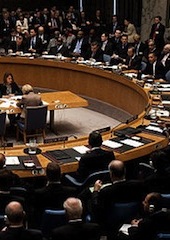Trade Secrets and the Return of the 99 Percent
What are the architects of the Trans-Pacific Partnership trade agreements trying to keep secret?
September 26, 2013

The second anniversary of Occupy Wall Street came and went last week with little media fanfare. The rapidly developing Trans-Pacific Partnership (TPP), a massive U.S.-led trade agreement that includes a dozen Pacific Rim nations, also continues to fly under the media radar.
The lackluster coverage of the TPP is easier to explain: the trade negotiations remain shrouded in secrecy.
Occupy Wall Street protestors count high among those who worry about the global fallout from the closed-door TPP negotiations. They are trying, with limited means and little success, to get the word out. For example, just last week Money Wars — a Star Wars parody troupe – leveled its satirical sights upon the TPP, “the wet dream of the 1%,” in New York City’s Times Square.
In Washington D.C., 60 more Occupy Wall Street activists, including a juggler dressed in a business suit and an enormous Obama mask dropping bowling pins labeled “peace,” “truth,” and “jobs,” similarly made their way to the office of U.S. Trade Representative Mike Froman to let him know that the TPP deal “is poop.”
A motley group made up of members from such organizations as CODEPINK, FlushTheTPP.org, Backbone Campaign, Earth First!, and Veterans for Peace put on an encore performance this week, covering Froman’s office with banners demanding the TPP text be released to the public.
What is so frightening about the TPP, according to its critics and protesters? They believe that the secretive TPP would “wipe clean” national sovereignty, making all nations “subservient to corporations.”
The primary goal of various recent theatrical protests has therefore been to draw American attention to the TPP, which has indeed received little national media attention, especially when contrasted to the previous widespread coverage of the NAFTA negotiations two decades past.
And on this point, at least, the protestors are right. The TPP negotiations deserve greater openness and national debate.
Keeping key parties in the dark
A variety of important issues remain hidden within the proposed trade agreement.
First, with many Democrats coming out in opposition, Obama is now leaning upon Republican congressmen to fast track the deal so as to see it concluded by year’s end.
Obama has therefore called upon Republicans to grant him the powers of Trade Promotion Authority, which would allow him to submit the TPP legislation to Congress for an amendment-free up-or-down vote. It appears that the trade agreement is making for unexpected Republican bedfellows — and isn’t open for debate within the halls of Congress.
Second, the TPP negotiations have been held amid great secrecy, giving some credence to Occupy Wall Street’s allusion to conspiratorial corporate wheelings and dealings, made behind closed doors amid smoke-filled rooms.
Even congressional committee members like Senator Elizabeth Warren (D-MA) are being kept in the dark as to what precisely is on the TPP negotiating table.
The group Just Foreign Policy is correspondingly offering a $60,955 reward to Wikileaks if it can make the TPP negotiating text publicly available. Surely greater transparency would alleviate — or illuminate — many of the fears held by critics of the trade agreement.
What’s hiding in the agreement?
Third, serious labor and environmental concerns surround the Pacific Rim deal. Little can be gleaned regarding what protections will be included, prodding the Teamsters and a variety of green organizations like the Sierra Club into action, as they fear the TPP could undermine international labor and environmental standards.
Conversely, Joshua Meltzer of the Brookings Institute predicts that the TPP could in fact lead to greater international efforts on behalf of climate change and environmental protection.
Fourth, despite the TPP’s free-trade pretensions, the deal will probably have a variety of protectionist strings attached, including the extension of patent provisions and extra-national pricing loopholes aimed to protect Big Pharma — and potentially harm global consumers.
Professor Innes Asher of the New Zealand-based Global Asthma Network suggests that the TPP “will most likely increase costs and reduce access to affordable medicines,” a precedent that would make it inordinately difficult to provide affordable medicine to poorer nations.
The chief negotiators for the 12 TPP signatories — the United States, Vietnam, Malaysia, Singapore, Japan, Brunei, Australia, New Zealand, Canada, Mexico, Peru and Chile — have just concluded the newest round of talks in Washington this past weekend.
Such meetings are occurring with ever more frequency — and secrecy — in order to successfully wrap up negotiations, demonstrating that the TPP remains high on the global agenda. We need transparency and healthy national debate now more than ever.
Editor’s note: See our previous coverage of Trans-Pacific Partnership trade negotiations secrecy, which also appeared in the New York Times.
Takeaways
Trade negotiations for the Transpacific Partnership remain shrouded in secrecy. What's being hidden?
Critics of the TPP say it would “wipe clean” sovereignty, making all nations “subservient to corporations.”
Theatrical protesters are right on one point: Trade negotiations deserve greater openness and national debate.
Trade talk secrecy gives credence to conspiracy theories of corporate wheeling-and-dealing behind closed doors.
Little can be gleaned regarding what labor and environmental protections will be included in the TPP.
Despite the TPP’s free-trade pretensions, the deal will probably have a variety of protectionist strings attached.

